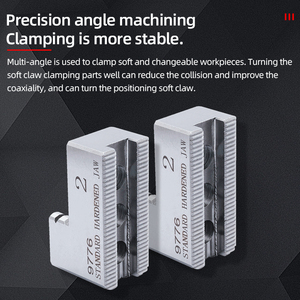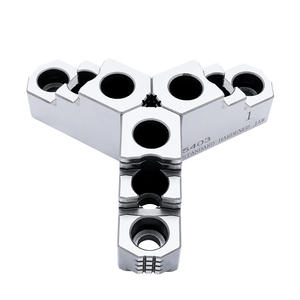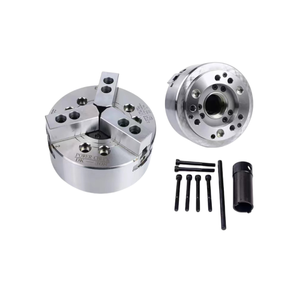
All categories
Featured selections
Trade Assurance
Buyer Central
Help Center
Get the app
Become a supplier

(2169 products available)
































Hydraulic operated lathe chuck is classified into several types based on design and application. Each type serves unique purposes, ensuring precision clamping in various machining operations.
Three-Jaw Chucks
Three-jaw hydraulic chucks are the most commonly used type in general lathe operations. They provide good centering accuracy and are suitable for gripping symmetric workpieces. The hydraulic operation ensures smooth and precise adjustments, making them ideal for mass production where quick setup changes are necessary.
Four-Jaw Chucks
Four-jaw chucks are versatile, allowing independent adjustment of each jaw. This feature provides superior clamping capabilities for irregularly shaped workpieces. When operated hydraulically, the adjustment remains user-friendly. Four-jaw chucks are widely used in industries that require holding complex or custom-shaped parts.
Soft Jaws
Soft jaws are essential features allowing custom adaptations for specific workpiece shapes. Made from softer materials like aluminum or steel, they reduce the risk of damaging delicate workpieces. During hydraulic chuck selection, soft jaws ensure that the apparatus is aligned with production requirements while safeguarding workpiece quality.
Power Chucks
Power chucks are advanced hydraulic chucks designed for automatic operation. They integrate with CNC lathes and robotic systems, providing quicker cycles. The chuck's design supports high gripping forces, ideal for tough materials. Their automation saves human labor and increases output, crucial for busy manufacturing settings.
The Hydraulic Lathe Chucks' material directly affects its durability, strength, and resistance to wear and tear. Manufacturers prioritize specific materials for constructing these chucks to ensure long-lasting performance and reliability.
High-Strength Steel Alloys
High-strength steel alloys are the primary material for a hydraulic-operated lathe chuck due to their toughness and resistance to deformation. These alloys, typically 4340 or 4140 steel, withstand heavy loads and repeated cycling. Furthermore, steel alloys are highly machinable, allowing precise manufacturing of the chuck's intricate components.
Tool Steel
Tool steel grades offer exceptional wear resistance, making them ideal for components subjected to high-stress, such as jaws and jaw guides. Grades like D2 or M2 are selected for their ability to maintain hardness even at elevated temperatures. This property ensures that the chuck retains its precision over extended use.
Cast Iron
Because of its excellent vibration-damping properties, cast iron is a standard choice for hydraulic chucks' main bodies. Grey cast iron provides a balance of strength and machinability. In addition, ductile cast iron offers higher tensile strength while maintaining good shock absorption. As a result, it is suitable for creating stable and robust chucks.
Aluminium Alloys
Aluminum alloys are the preferred material for producing hydraulic chucks requiring lightweight construction without sacrificing strength. Due to the low density of aluminum and the high strength of alloying elements like copper or zinc, these chucks are ideal for equipment in aerospace or automotive industries. They provide corrosion resistance and ensure longevity.
Precision and Tolerance
Precision and tolerance are fundamental factors when choosing a hydraulic-operated lathe chuck. The centering accuracy directly impacts workpiece quality. Higher precision is vital in industries like aerospace and medical manufacturing. Therefore, select a chuck with proven tolerance records to ensure it meets these essential requirements.
Grip Strength
Grip strength is the primary requirement of chucks in securely holding various materials. A hydraulic machine tool chuck should exert enough pressure to handle heavy stocks without slipping. Thick materials may need variable grip force. Thus, consider the chuck's capability to adjust grip strength according to diverse workpiece requirements.
Material Compatibility
The materials composing the chuck must match the workpieces and machines' tasks. Tougher metals like titanium demand a powerful chuck manufactured from high-grade steel or metal partnerships. Conversely, softer materials may utilize lightweight aluminum chucks. Therefore, ensure the selected chuck is compatible with specific material varieties used in business operations.
Durability and Maintenance
Durability is an essential factor because it determines the hydraulic chuck's lifespan in tough-working situations. Examine aspects of construction, including wear and corrosion-resistant features. Higher chucks can require less frequent maintenance. Hence, opt for one that meets business needs with minimal disruption.
Cost and Budget
Hydraulic chucks are different based on their prices and fiscal suitability for businesses intending to purchase several units in bulk. Consider long-term benefits over a single chuck. Sometimes, investing in quality provides greater returns in moderation and lifespan. Therefore, determine the budget within realistic constraints and based on cost vs. benefits.
Increased Efficiency
Hydraulic-operated chucks significantly increase lathes by reducing manual gripping adjustments. The hydraulic system allows fast and exact jaw movement, minimizing setup time. In addition, this efficiency enables industries to process more workpieces quickly. Therefore, businesses gain an edge from their improved productivity and reduced operating costs.
Enhanced Precision
As there is precise hydraulic control during operation, it leads to a consistent and firm grip on the workpieces. This pressure uniformly eliminates chances of slippage during machining. Ultimately, it results in superior accuracy in the produced parts. In addition, better accuracy limits waste and rework. This outcome is particularly vital in precision-focused industries.
Versatility
The hydraulic chucks work well with different materials and shapes, from metals to composites. This adaptability enables industries like automotive, aerospace, and manufacturing to process various workpieces without needing additional equipment. In addition, versatility broadens application reach. It increases the value of chucks across many commercial operations managing diverse needs.
Safety Improvements
The transition from manual to hydraulic operation improves workplace safety significantly, especially with heavy or awkwardly shaped workpieces. Less manual handling decreases the risk of worker injury. The risk is eliminated when machines are designed with chucks that cover better safety standards, which also reduces expenses linked to injury management and insurance claims.
Stronger Grip for Tough Materials
Hydraulic chucks provide a stronger grip compared to mechanical ones. Consequently, they are ideal for handling tough materials such as hardened steel and titanium. This attribute is highly regarded since it avoids material slipping during machining. As a result, businesses achieve better finished product quality and higher customer satisfaction standards.
A1: A hydraulic chuck is a work-holding device used on lathes where a hydraulic system controls the movement of the jaws to grip a workpiece.
A2: The hydraulic lathe chucks benefits include improved grip strength, better precision, and faster setup times compared to manual chucks.
A3: A hydraulic chuck is operated by pumping hydraulic fluid, which moves the jaws to grip or release the workpiece.
A4: In mass production, hydraulic chucks are preferred because they provide consistent clamping force, reducing variation in parts.
A5: The automobile, aerospace, and machinery manufacturing industries commonly use hydraulic chucks for their lathing operations.